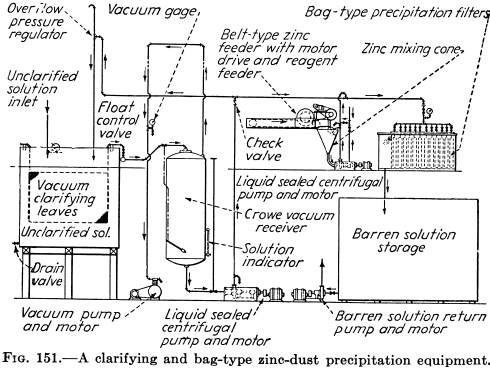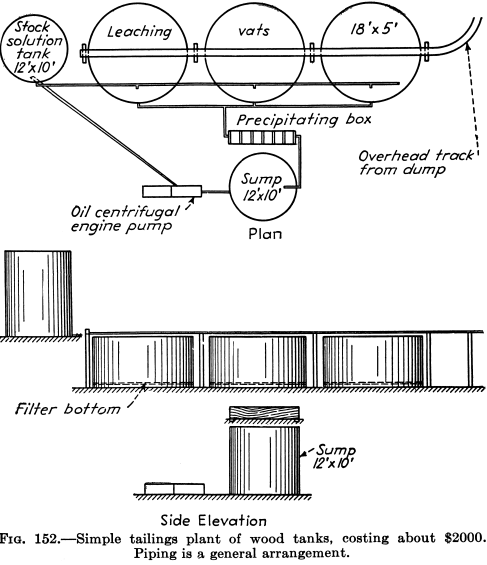The simplest precipitation equipment for a small mine is what is known as a zinc-box (Fig. 150). This consists of a long, narrow, sloping, wood or painted sheet-iron box divided into wide compartments or cells which are separated by baffle-boards and narrow compartments. The bottom of the box slopes to one side to facilitate the clean-up through plug-holes which discharge into a small launder. Near the bottom of each large compartment is a ledge on which is supported a heavy wire screen-tray. These compartments are filled firmly yet are springy with zinc shavings or filament. The gold- and silver-bearing solution is turned into the first narrow compartment, and the baffle, which does not reach the bottom, deflects the solution under the tray holding the zinc. The solution flows upward through the zinc, over the side of the compartment, down by the next baffle to the next lot of zinc, and so on, through 6 to 10 cells to the discharge, whence the solution flows to a sump or storage-tank. At this point it should be practically barren of precious metals. One cubic foot of filament will serve 6 to 10 tons of solution a day.
From time to time during a mill run the zinc falls in the compartments, but it should be kept to the surface. The supply of solution is shut off; the zinc is gently lifted out from one cell to another until full; and the last cell or two are filled with new zinc. Then the flow is re-started. If the last one or two cells do not collect any gold, they need not be filled.

FIG. 150. A precipitation box for zinc shavings. This is made of plank, but painted flat iron that has been riveted together is suitable. This box is large enough for a small plant; a larger one may need up to ten cells or compartments. To save wood or iron, two boxes can be built back to back, the middle piece serving as a divider. The other box would slope the other way. The box should have a strong hinged and locked lid made of 2- by 4-inch timber and ½-inch heavy wire screen.
At clean-up time the cells are siphoned out. The long filament is washed in the top cell or in a separate tub, and the gold-silver sludge is run out of the compartments and is mixed with that in the tub; the washed zinc is returned to the precipitaiing-box. Or all the zinc and the sludge are taken out and dissolved in weak sulphuric acid, and the residue is washed; filtered; partly dried; mixed with sand, borax, and soda ash; and melted in a graphite crucible.
Zinc shavings, which is 1/16 inch wide and 1/500 inch thick, costs little more than zinc sheet and is quoted at around 22 cents per pound in large lots and 24 cents for small lots—say 100 pounds.
Precipitation is aided by the following means:
- Clarify the solutions by flowing them through a vat having a regular filter bottom atop of which are several inches of sand or through sand or some porous material placed in the first compartment or two of a zinc-box or through vacuum leaves of Merrill design.
- Maintain solution strength for good precipitation by regular feed of a drip of strong solution, say 10 per cent cyanide.
- Improve precipitation by a regular drip of 10 per cent solution of lead acetate or lead nitrate.
- Reduce the lime in the solutions as low as possible to prevent bulky precipitate resulting from the action of pyrrhotite.
- Prevent deposition of copper by drips of strong cyanide and lead acetate or nitrate.
- Prevent deposition of sulphate of lime by adding soda ash to the solutions.
- Test the strength of the inflowing (0.02 to 0.05 per cent) and outgoing (effluent) solution regularly and assay the latter for gold and silver which should not exceed a trace.
- Good precipitation is shown by numbers of bubbles of hydrogen gas rising to the surface of the cell or compartment.
Zinc Dust
This precipitant is mostly minus 200 mesh in size, consists mainly of zinc (95 per cent) with some oxide and lead, and costs around 8 cents per pound wholesale.
For the Merrill-Crowe clarification-de-aeration-precipitation process there are three types of equipment, the choice of which depends upon the size of a plant or the tonnage of solution handled daily. These are the bag-filter type, vacuum-leaf filter type, and filter-press type. The first is particularly suitable for precipitating small solution tonnages whether from the cyanidation of ore, concentrates, or tailings.
Briefly, a bag-filter precipitating unit (Fig. 151), which occupies small space, consists of a tank in which are vacuum-clarifying leaves, a vacuum receiver for the clarifier and for de-aerating (removing oxygen) cyanide solutions, a zinc-dust feeder for adding zinc to the de-aerated solution, and a bag-type filter through which the solution passes and leaves behind the precipitate of gold and silver. The barren solution is re-used in leaching or other operations. A single, liquid-sealed centrifugal pump is used to effect the passage of the pregnant solution through the successive steps of clarification, de-aeration, and precipitation.
The Merrill-Crowe process of precipitation of gold and silver on zinc dust has the following advantages over zinc shavings or filament:
(1) In the absence of oxygen in solutions, the formation of the troublesome white precipitate or hydrated zinc oxide is prevented; (2) as the filter-cloths are always coated with a layer of fine precipitant and precipitate, solution cannot escape coming in contact with the zinc dust; (3) the effective surface of zinc dust exposed

is many times that of zinc filament; (4) the consumption of dust is much lower than that of filament; (5) precipitates are lower in unconsumed zinc and higher in gold and silver; (6) there is a decrease in cyanide consumption; (7) the effluent or solution leaving the precipitating system is lower in precious metals; (8) less labor is required in handling precipitates; (9) a complete clean-up is possible.
Used tanks and pumps might be procured from some near-by worked-out mine whose owners are willing to sell the material, but they are available from dealers in used equipment.
Tailings can be moved by wheelbarrow; by motor-truck; by scraper pulled by animal, by winch, or by motor-truck; and by scraper or bulldozer ahead of a motor-truck.
Plant for the treatment of sand is simple—several leaching vats with slat filter bottom and cloth or matting caulked around with rope or strips of cloth, solution tanks, and a pump or two.
The treatment of slime requires much more equipment than the simple handling of sand. The minimum requirements are agitators—air or mechanical—pumps, filters or decanting vats, and precipitators.
If it is desired to make round tanks on the job, the simplest method is the use of corrugated iron for the side and flat iron for the bottom, 16- or 18- to 20-gage thickness. The sheets are lapped several inches and double-riveted. To strengthen the side, the top sheet is turned over on a ½-inch rod for about 1 inch or slats are nailed or screwed to the top all around. When built, a tank is carefully painted all over with tar or pitch. Tanks should be laid on smooth ground or sand or on a number of boards.

The capacity of vats varies from 35 to 100 tons. Figures 152 and 153 show simple sand-leaching plants.
Square tanks may be built entirely of flat iron riveted, and the sides strengthened by lengths of lumber, say, 2- by 4-inch, driven into the ground and against the tank to support it.
